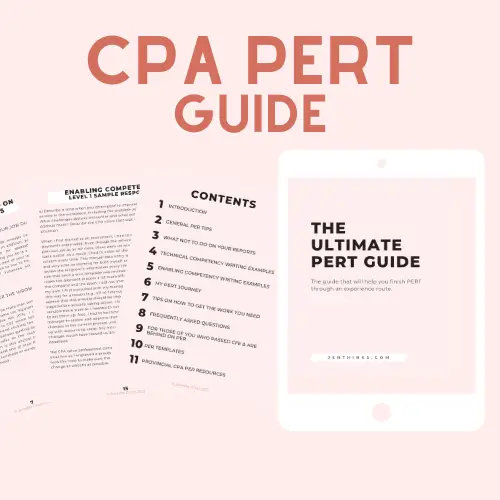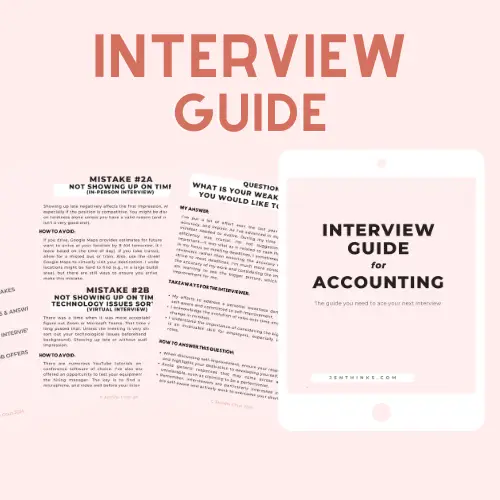Many of you found my blog through my CPA PERT guide which is one of the most read posts in 2020. I also know a lot of you are looking for examples for both enabling and technical competencies. I heard you because I struggled with that as well. I remembered looking everywhere online for some examples (not to copy because of obvious reasons but also your manager verifies the accuracy of your reporting) in hopes of getting some ideas of what/how I should write. If you read my post on my first CPA PERT submission, you would know that I learned what to write the hard way (i.e., getting level 0) at the end as I wasn’t able to find much online.
Note, these examples are by no means the only way to write your responses. I am sharing because these technical experiences were assessed as Level 1 for their respective competencies. I want to warn against using any of my examples as your own as CPA takes plagiarism very seriously. My examples are meant to be a guide for you to apply to your unique situation and work.
As always, I strongly suggest checking out the official CPA PERT resource centre for your provincial body. It will contain the most up-to-date information for you.
Read all CPA PERT posts here.
What Position Did I Get These Experiences In?
Before we begin, I want to highlight that I got these experiences while I was working in the Accounts Payable department (began as AP Clerk, then promoted to Senior AP clerk) for a software company. Many CPA candidates think that you must work in a traditional accounting role (e.g., Junior Accountant, Corporate Accountant, Accounting Clerk) to gain CPA PERT-qualified experiences. This is a myth as proven by my experience. However, being in AP for the entire time will most likely not get you all of the required experiences for CPA PERT. Therefore, you can start in a role like AP or AR and plan your next move accordingly (e.g., move to an accounting role within the same company or look for an opportunity elsewhere).
Also, you are required to submit your current job description to CPA for an assessment before reporting any experience. This will ensure your job duties satisfy their requirements.
Are you looking for a comprehensive guide for PERT with example Level 1 & 2 full responses, tips, templates and more? Check out my CPA PERT Guides!
Technical Competency Examples
Accounts Payable Monthly Close Procedure
Competency: Financial Reporting – Accounting Policies and Transactions (FR2)
Tasks: Monthly AP close tasks, i.e., making sure all invoices received by Day 2 noon have been entered & obtaining information from departmental leaders for accrual purposes
Level 1 Submission
I identified two tasks and wrote about them both. The first task was how I ensured all vendor invoices received were entered in the correct period before AP closed. I explained why this was critical (e.g., accuracy of reporting on expenses) and what assertions I would be testing (e.g., completeness, cut-off etc). I then detailed the steps I take each month to make sure myself and the AP team have entered all invoices received in our ticketing system. I also talked about the treatments for invoices for services pertaining to the previous month and future months (e.g., amortization). The second task was how I ensured we are preparing the accrual accurately. I mentioned how this was in compliance to our financial reporting framework. At my then-company, the AP team prepared the accrual information for the accountant to enter. Therefore, my team was responsible for obtaining the information from the departmental leaders. I also mentioned how I took an extra step to make sure the recurring expenses have either been entered already and included for accrual purposes.
RELATED POST – CPA PERT – Enabling Competencies Examples
Evaluation of Current Expense Reimbursement Controls
Competency: Audit and Assurance – Internal Control (AA1)
Task: evaluate the existing process and controls for the employee expense reimbursement system against risks
Level 1 Submission
As the AP clerk, I was responsible for the processing of employee expense reimbursements. For my submission, I first identified the importance of having sufficient controls for expense reimbursements (e.g., money going out). I then detailed our existing process and existing internal controls against risks such as error and misappropriation of assets. I then identified any weaknesses such as the reliance on manager’s approvals and grey areas on our existing expense policy. I then highlighted current inefficiencies such as the manual review process as we weren’t taking advantage of features offered by our service (e.g., Concur).
Performance Measure for AP Team
Competency: Management Accounting – Organizational/ Individual Performance Measurement (MA4)
Task: develop appropriate KPI (key performance measures) for AP team’s performance
Level 1 Submission
I first explained what and how the issue presented itself. My then-manager and I realized a lack of established KPIs to assess individual performance for AP clerks when our new hires were not performing at the level we expected them to be. I identified what tasks the new hires struggled with the most and performed a quantitative analysis by pulling time-stamped data from both experienced clerks and new hires. Once I confirmed there was a discrepancy between time spent on the same task, I asked them to show me how they got the tasks done. I then identified the root cause (e.g., an inefficient method) and suggested the corrective action necessary (e.g., standardization of process). I also wrote about the KPIs we came up with at the end and explained why they were appropriate.
Preparation for Financial Statement
Competency: Financial Reporting – Financial Report Preparation (FR3)
Tasks: Preparing note disclosures for a number of sections including commitment and contingencies
Note: this task does not normally fall under the job description of an AP clerk, however, I got the opportunity to work on this as my manager was aware of my CPA PERT requirement
Level 1 Submission
Even though I worked on a number of sections for our financial statement (e.g., AP and Accrued Liabilities), I wrote in details for only the most complex one. I detailed my work on the working paper and note disclosures for the Commitment and Contingencies section in my submission. In order to highlight its complexity, I highlighted the number of leases (aka the commitment) and entities my company had. I mentioned the accounting framework we followed as well. The bulk of the submission related to the steps I have taken to ensure the completeness and accuracy of the data for my working paper (e.g., compared to last year’s data, confirmed with the department responsible for leases). I also mentioned who reviewed my work before it was submitted to the auditor.
Tips On How To Get The Experience You Need At Work
As I have mentioned above, getting to prepare financial statement is not normally under the job description of an AP clerk. I was given the opportunity as my manager was aware of my CPA PERT requirement and offered the chance (and I took it without hesitation).
If you are not sure if anything you work on qualifies, I suggest reviewing Appendix A on this PDF (page 57). If you already have a CPA mentor or a manager who is a CPA, do not hesitate to reach out for help. However, do your homework and be prepared before setting up the meeting so it shows that you are respectful of their time. It will be a good idea to identify the technical competencies you are interested in before the meeting so you can ask your manager if he/she can think of any experience/projects that you can be a part of in the future. Note, it is best to start this process as early as possible as some experiences are only available once or for a limited time. For example, your company would only prepare the annual financial statement once a year so advance planning is required.



